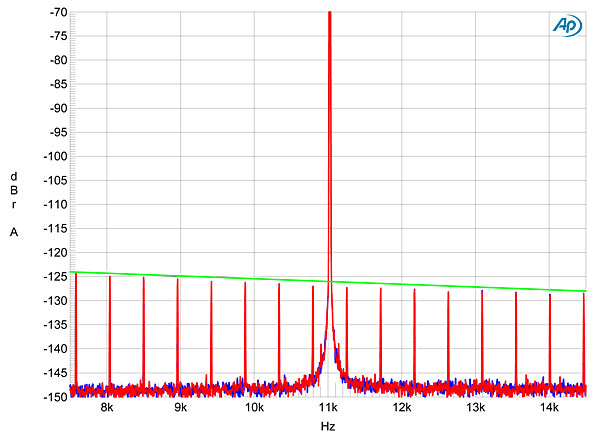I found the names of the files in the 30 Hz jitter test (the actual dropbox link no longer works). The files were revised and my results are for those but can't find that list just now.
And here are my ABX test results from bottom to top (easy to hard):
foo_abx 1.3.4 report
foobar2000 v1.3.2
2014/06/18 16:44:39
File A: C:\Users\Amir\Music\Arny's 30 Hz Jitter File\Arny's new files\no jitter.wav
File B: C:\Users\Amir\Music\Arny's 30 Hz Jitter File\Arny's new files\30 Hz jitter strong level .025.flac
16:44:39 : Test started.
16:45:05 : 01/01 50.0%
16:45:15 : 02/02 25.0%
16:45:28 : 03/03 12.5%
16:45:36 : 04/04 6.3%
16:45:54 : 05/05 3.1%
16:46:17 : 06/06 1.6%
16:46:29 : 07/07 0.8%
16:46:45 : 08/08 0.4%
16:46:55 : 09/09 0.2%
16:47:05 : 10/10 0.1%
16:47:19 : 11/11 0.0%
16:47:33 : 12/12 0.0%
16:47:36 : Test finished.
----------
Total: 12/12 (0.0%)
===================
foo_abx 1.3.4 report
foobar2000 v1.3.2
2014/06/18 16:39:16
File A: C:\Users\Amir\Music\Arny's 30 Hz Jitter File\Arny's new files\no jitter.wav
File B: C:\Users\Amir\Music\Arny's 30 Hz Jitter File\Arny's new files\30 Hz Severe Jitter 0.05.flac
16:39:16 : Test started.
16:39:52 : 01/01 50.0%
16:40:26 : 02/02 25.0%
16:40:38 : 03/03 12.5%
16:40:48 : 04/04 6.3%
16:40:58 : 05/05 3.1%
16:41:07 : 06/06 1.6%
16:41:24 : 07/07 0.8%
16:41:32 : 08/08 0.4%
16:41:51 : 09/09 0.2%
16:42:04 : 10/10 0.1%
16:42:12 : 11/11 0.0%
16:42:21 : 12/12 0.0%
16:42:43 : Test finished.
----------
Total: 12/12 (0.0%)
===================
foo_abx 1.3.4 report
foobar2000 v1.3.2
2014/06/18 19:04:40
File A: C:\Users\Amir\Music\Arny's 30 Hz Jitter File\Arny's new files\no jitter.wav
File B: C:\Users\Amir\Music\Arny's 30 Hz Jitter File\Arny's new files\30 Hz noticable jitter 0.0125.flac
19:04:40 : Test started.
19:05:27 : 01/01 50.0%
19:05:54 : 02/02 25.0%
19:06:19 : 03/03 12.5%
19:06:35 : 04/04 6.3%
19:06:57 : 05/05 3.1%
19:07:16 : 06/06 1.6%
19:07:43 : 07/07 0.8%
19:08:15 : 08/08 0.4%
19:08:37 : 09/09 0.2%
19:09:05 : 10/10 0.1%
19:09:30 : 11/11 0.0%
19:10:05 : 12/12 0.0%
19:10:09 : Test finished.
----------
Total: 12/12 (0.0%)
=================
Then it starts to get hard. See my multiple trials to get this level right:
foo_abx 1.3.4 report
foobar2000 v1.3.2
2014/06/21 14:50:24
File A: C:\Users\Amir\Music\Arny's 30 Hz Jitter File\Arny's new files\no jitter.wav
File B: C:\Users\Amir\Music\Arny's 30 Hz Jitter File\Arny's new files\30 Hz jitter marginal level .00625.flac
14:50:24 : Test started.
14:51:40 : 01/01 50.0%
14:52:05 : 02/02 25.0%
14:52:33 : 03/03 12.5%
14:52:57 : 03/04 31.3%
14:53:22 : 03/05 50.0%
14:54:11 : 03/06 65.6%
14:54:54 : 04/07 50.0%
14:55:21 : 05/08 36.3%
14:56:02 : 06/09 25.4%
14:56:55 : 07/10 17.2%
14:57:24 : 08/11 11.3%
14:58:17 : 08/12 19.4%
14:59:37 : 09/13 13.3%
15:00:44 : 10/14 9.0%
15:03:01 : 10/15 15.1%
15:04:11 : 11/16 10.5%
15:04:32 : Test finished.
----------
Total: 11/16 (10.5%)
foo_abx 1.3.4 report
foobar2000 v1.3.2
2014/07/09 09:31:59
File A: C:\Users\Amir\Music\Arny's 30 Hz Jitter File\Arny's new files\no jitter.wav
File B: C:\Users\Amir\Music\Arny's 30 Hz Jitter File\Arny's new files\30 Hz jitter marginal level .00625.wav
09:31:59 : Test started.
09:32:47 : 01/01 50.0%
09:32:58 : 02/02 25.0%
09:33:09 : 03/03 12.5%
09:33:22 : 04/04 6.3%
09:33:33 : 04/05 18.8%
09:34:03 : 05/06 10.9%
09:34:18 : 06/07 6.3%
09:34:30 : 07/08 3.5%
09:34:46 : 08/09 2.0%
09:34:56 : 08/10 5.5%
09:35:19 : 09/11 3.3%
09:35:34 : 10/12 1.9%
09:35:49 : 11/13 1.1%
09:36:38 : 12/14 0.6%
09:37:21 : 12/15 1.8%
09:37:41 : 13/16 1.1%
09:37:52 : 14/17 0.6%
09:38:13 : 15/18 0.4%
09:38:26 : 16/19 0.2%
09:38:39 : 17/20 0.1%
09:38:45 : Test finished.
----------
Total: 17/20 (0.1%)
==================
And the final test:
foo_abx 1.3.4 report
foobar2000 v1.3.2
2014/07/09 17:39:55
File A: C:\Users\Amir\Music\Arny's 30 Hz Jitter File\Arny's new files\no jitter.wav
File B: C:\Users\Amir\Music\Arny's 30 Hz Jitter File\Arny's new files\30 Hz jitter barely noticable level .015.flac
17:39:55 : Test started.
17:40:40 : 00/01 100.0%
17:41:30 : 01/02 75.0%
17:41:41 : 02/03 50.0%
17:41:52 : 03/04 31.3%
17:42:04 : 04/05 18.8%
17:42:19 : 05/06 10.9%
17:42:32 : 06/07 6.3%
17:42:46 : 07/08 3.5%
17:42:58 : 07/09 9.0%
17:43:12 : 07/10 17.2%
17:43:27 : 07/11 27.4%
17:43:42 : 08/12 19.4%
17:43:53 : 08/13 29.1%
17:44:15 : 08/14 39.5%
17:44:46 : 09/15 30.4%
17:45:00 : 10/16 22.7%
17:45:12 : 11/17 16.6%
17:45:30 : 12/18 11.9%
17:45:52 : 12/19 18.0%
17:46:23 : 13/20 13.2%
17:46:28 : Test finished.
----------
Total: 13/20 (13.2%)
============
As you see I could no longer achieve 95% confidence.
I took the initiative to run these tests. It is not hard to create these tests. Just a modicum of effort needs to go into such strong claims that run counter to full science of psychoacoustics.


